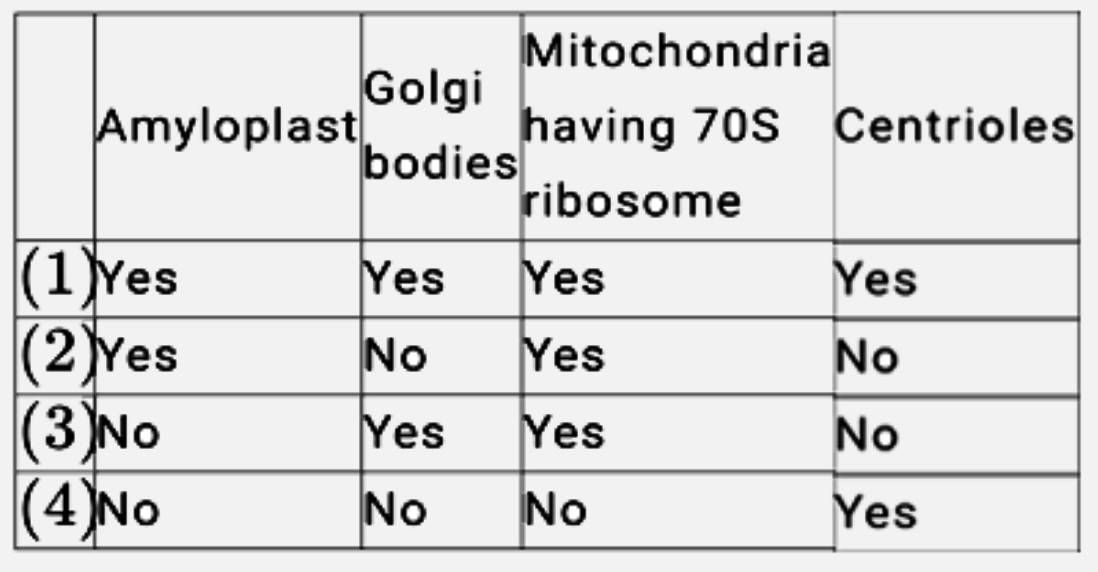Large membranous sacs that are more prevalent in plant cells and some protozoa than in animal cells are called :
vacuoles
vesicles
glyoxisomes
lysosomes
The correct Answer is:A
Step-by-Step Solution:
1. Understanding the Question: The question asks for the name of large membranous sacs that are more prevalent in plant cells and some protozoa than in animal cells.
2. Identifying the Options: The options provided are:
- A) Vacuole
- B) Vesicles
- C) Glyoxysomes
- D) Lysosomes
3. Analyzing Each Option:
- Vacuole: These are large, membrane-bound sacs found in plant cells and some protozoa. They are primarily involved in storage of substances such as nutrients, waste products, and other materials.
- Vesicles: These are smaller membrane-bound sacs that transport materials within the cell but are not specifically large or prevalent in plant cells.
- Glyoxysomes: These are specialized organelles found in plants, primarily involved in the conversion of stored fats into sugars, but they are not large membranous sacs.
- Lysosomes: These are membrane-bound organelles that contain enzymes for digestion within the cell, but they are not primarily storage organelles.
4. Conclusion: Based on the analysis, the correct answer is A) Vacuole. Vacuoles are indeed large membranous sacs that serve as storage compartments in plant cells and some protozoa.
5. Reasoning: Vacuoles are larger in plant cells because they store nutrients and waste products, which is crucial for the plant's survival, especially when they cannot photosynthesize (e.g., at night).
- A) Vacuole
- B) Vesicles
- C) Glyoxysomes
- D) Lysosomes
- Vacuole: These are large, membrane-bound sacs found in plant cells and some protozoa. They are primarily involved in storage of substances such as nutrients, waste products, and other materials.
- Vesicles: These are smaller membrane-bound sacs that transport materials within the cell but are not specifically large or prevalent in plant cells.
- Glyoxysomes: These are specialized organelles found in plants, primarily involved in the conversion of stored fats into sugars, but they are not large membranous sacs.
- Lysosomes: These are membrane-bound organelles that contain enzymes for digestion within the cell, but they are not primarily storage organelles.
Topper's Solved these Questions
- CELL : THE UNIT OF LIFE BOOK - ICSECHAPTER - CELL : THE UNIT OF LIFE EXERCISE - Test Your Progress (Fill in the blanks with appropriate words)
29 Videos
- CELL : THE UNIT OF LIFE BOOK - ICSECHAPTER - CELL : THE UNIT OF LIFE EXERCISE - Test Your Progress (State whether the following statements are true or false )
45 Videos
- CELL - THE UNIT OF LIFEBOOK - ICSECHAPTER - CELL - THE UNIT OF LIFEEXERCISE - REVIEW QUESTIONS (LONG ANSWER TYPE QUESTIONS)
14 Videos
- CELL CYCLE AND CELL DIVISION BOOK - ICSECHAPTER - CELL CYCLE AND CELL DIVISION EXERCISE - REVIEW QUESTIONS ( LOOK AT THE FIGURE BELOW)
2 Videos
Similar Questions
Large plant cells are
View SolutionName two structures that are found only in plant cells and are absent in animal cells.
View SolutionHow does cytokinesis in plant cells differ from that in animals cells ?
View SolutionHow does cytokinesis in plant cells differ from that in animal cells?
View SolutionA plant cell can be identified from an animal cell by the :
View SolutionA large and mature plant cell has
View SolutionAnimal cells have more mitochondria than plant cells because
View SolutionThe plasma membrane of plant and animal cells
View SolutionSelect the features that are common to animal and plant cells ?

View SolutionThe cells of the embryo sac in the chalazal end are called as
View Solution
